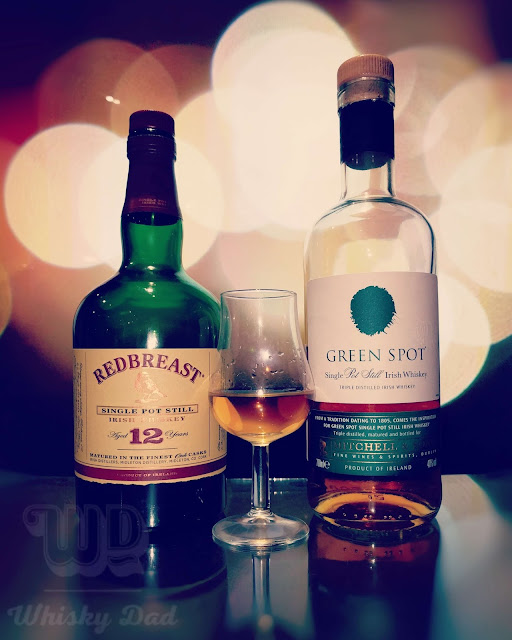Irish whiskey (spelt with the 'e') comes in many forms but the only thing that makes a whiskey Irish, legally speaking, is that it comes from Ireland. Sure, it has the same base rules as any whiskey regarding ingredients and minimum age etc. but it doesn't need to be produced in any special way to be considered Irish whisky. It does not need to be triple distilled, plenty of Scotch is triple distilled and plenty of Irish whiskey is double distilled. So if the only difference between Irish whiskey and Scotch is the country of origin, is there really any difference?
Amongst all the Irish whiskey there is one variety produced under very few labels that in my opinion, is quintessentially Irish and is so, for an equally Irish reason - sticking it to the English. Let's start with a quick history lesson. The Irish are commonly recognised to have invented whiskey some time in the 15th century, but it soon crossed the North Channel to Scotland. By the turn of the 20th century, the Irish whiskey industry dominated Scotch sales until the Irish War of Independence cut off exports to Commonwealth countries and the rise of the temperance movement in the US, one of the biggest export markets for Irish whiskey, led to the introduction of prohibition. These events and further unrest in Ireland, crippled the once great Irish whisky industry in a matter of decades. The Scotts, on the other hand, lacked the affinity to the temperance movement that many Irish had and pounced on the opportunity to break into the now illicit North American market and never looked back. Ironically, the Scotts ramped up production through the use of an Irish invention, the Coffey Still, allowing them to produce large quantities of 'blended' whisky that better suited US tastes.
Now while the Irish may be credited with the invention of whiskey and the Scotts with its commercialisation, the English, are credited with the taxation of whiskey. In the 18th century, Scotland was home to hundreds, perhaps thousands of unregulated 'backyard' stills as farmers used whisky to convert bulky barley supplies into far more profitable, less likely to spoil and transportable whisky. The exact number of stills was unknown and that was precisely the problem as far as the tax man in London was concerned. You see, in 1785 it was ordered that whisky was to be taxed as it was a far too lucrative commodity for the Crown not to get a cut. The Scotts did not take well to this news and kept producing from illicit stills hidden away in the highlands for decades but the Irish took tax evasion to a whole new level.
Malted and Unmalted Barley
When producing whisky, barley needs to be malted (made to sprout or germinate) in order to release essential plant enzymes. These enzymes are what convert hard starches within the barley into soft starches that are able to be converted to sugars when mixed with hot water inside the Mash Tun. The sugars provide a source of food for the yeast during fermentation. The English knew that malted barely was essential to whisky production but not for traditional farming, so naturally, they taxed it. Now, this is what makes Single Pot Still whiskey so wonderfully Irish. The Irish were not stupid, they also knew a thing or two about whiskey (they did invent it after all) specifically, they knew that only around 30% of the total barely used had to be malted in order to produce enough of the essential plant emzymes. Since only malted barely was taxed, they tried making whiskey with just 30% malted barley, slashing their tax bills by seventy percent! Well played Irish whiskey makers, well played.
The term Single Pot Still (it used to be called 'Pure Pot Still') is confusing because it means one thing literally and another in the context of Irish whiskey. A pot still is a copper vessel that is heated and used for distilling whisky wash into a clear spirit. Many whiskies are made with just one or a 'single' pot still but they are not Single Pot Still whiskey. Single Pot Still whiskey, in the Irish whiskey context, is whiskey made with a combination of malted and unmalted barely and in my opinion, is the only true Irish whiskey.
Single Pot Still Irish Whiskeys
Sadly, there are very few Single Pot Still Irish whiskeys on the market today, in fact, you can count them on one hand; Redbreast, Green Spot and Yellow Spot, Powers and Middleton are about the only labels readily available. They are characterised by their unique flavour profile and this uniqueness is why I consider Single Pot Still whiskey to be the quintessential Irish whiskey. The mixture of malted and unmalted barley (and sometimes other grains) produces a full body (think red wine mouthfeel) and a spicy character. Single Pot Still whiskeys are fruity on the nose and fresh smelling. I find them very easy to drink neat and quite moreish, it is always difficult to settle for only a single dram. So if you feel like an Irish whiskey next St Patrick's Day (or any day for that matter) try a Single Pot Still Irish whiskey, the most Irish of Irish whiskeys.


Post a Comment